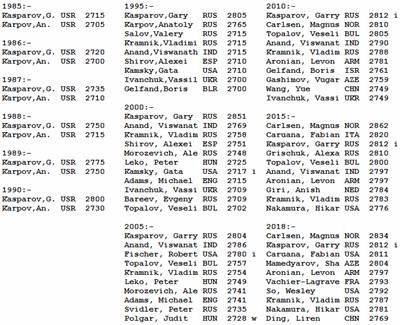Breaking the 2800 Barrier
A few months ago I opened Breaking the 2700 Barrier (June 2018), by saying,
No, I'm not talking about achieving a 2700 rating. I'm talking about post no.2700 on this blog.
I continued by discussing the history of chess players rated 2700 or more, then closed the post saying,
To break 2800, all I have to do is write another 100 posts.
Post no.2800 was A Conversation with Demis Hassabis a few weeks ago, but given the flurry of posts on this blog for the 2018 Carlsen - Caruana match that finished last week, I'm only finding spare time now. In a nutshell, the following chart shows the history of players rated 2800 or more.

The first column shows the evolution of top ratings during the second half of the 1980s, taken from the January list for each year. Throughout that period there were only two players rated over 2700, and Garry Kasparov was the first to break the 2800 barrier at the end of that decade.
The second column shows the top players after further intervals of five years: 1995, 2000, and 2005. Kasparov continued to head the list, but the number of 2700 players expanded steadily.
A little 'i' after a player's name means 'inactive'. FIDE hasn't always been consistent with the 'i' flag and Bobby Fischer made a sudden appearance in 2005, perhaps because he was in the news for having been detained in Japan.
A little 'w' means 'woman'. It appears only once on the chart, in 2005, when Judit Polgar made the top-10 list of all players. Note that there are not separate rating systems for men and women. All tournaments, even when restricted to women (where Judit Polgar never participated), are rated using the same methods and criteria.
The last column shows top-10 lists for the current decade: 2010, 2015, and 2018. For the first time we see players other than Kasparov rated over 2800.
I'll be back in another 100 posts to write 'Breaking the 2900 Barrier'. It promises to be a short post.




No comments:
Post a Comment